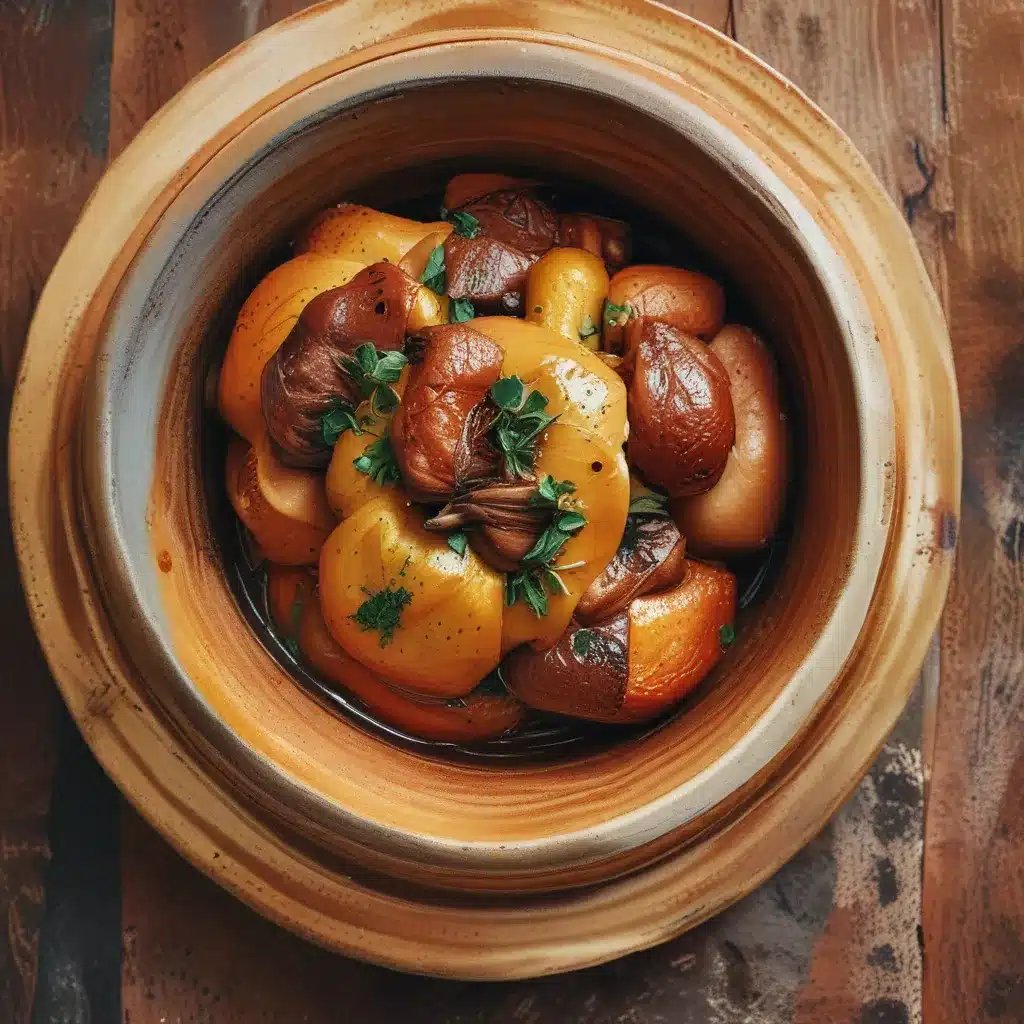
The Moroccan Microwave: Slow Cooking Secrets from the Medina
I’ll never forget the first time I tried a Moroccan tagine. It was a sweltering day in Marrakech, and I was wandering the bustling medina, dodging donkeys and haggling shopkeepers, when the unmistakable aroma of simmering spices lured me into a tiny roadside cafe. There, bubbling away over hot coals, was a vibrant red tagine, its conical lid steaming with the promise of slow-cooked perfection.
As I settled onto a low stool and the proprietor ladled the fragrant stew into a shallow bowl, I was transported. The tender lamb, the sweet prunes, the toasted sesame – it was like nothing I’d ever tasted. With each bite, I was discovering new layers of flavor, a symphony of spices that danced on my tongue. It was then that I understood the true magic of the tagine, this unassuming earthenware vessel that had become the heart and soul of Moroccan cuisine.
As author Lucy Stewart so eloquently describes, the tagine is more than just a cooking pot; it’s a “Moroccan microwave” that promotes the retention and return of moisture, ensuring that every ingredient is infused with flavor. And for the hardworking merchants of the medina, it was the ultimate convenience food – a one-pot wonder that could simmer away while they tended to their stalls, providing a hot, nourishing meal at the end of a long day.
Unlocking the Secrets of Tagine Cooking
But what is it about the tagine that makes it so special? Is it simply the vessel itself, or is there more to the art of tagine cooking? To unravel this mystery, I knew I had to delve deeper into the history and traditions of this iconic Moroccan dish.
First and foremost, the tagine is a Berber creation, a culinary legacy of the North African indigenous people who have inhabited the region for centuries. As the blog post explains, the tagine is a “slow-simmered stew of northwestern Africa traditionally cooked in a covered earthenware pot.” This unique pot, with its distinctive flat base and conical lid, is designed to trap steam and ensure that the ingredients are gently cooked to perfection.
But the true magic of the tagine lies not only in its construction, but also in the slow, patient cooking process. Unlike the hurried, high-heat cooking methods of the West, tagine recipes are all about low and slow, allowing the flavors to meld and the textures to become silky smooth. As Lucy Stewart observes, the slow simmering of a tagine allows even the toughest cuts of meat to become fall-off-the-bone tender, while the vegetables and fruits soak up the rich, aromatic broth.
But the real secret to a truly exceptional tagine lies in the spices. Moroccan cuisine is renowned for its complex and nuanced blend of spices, from the earthy cumin and ginger to the sweet cinnamon and fragrant saffron. These spices are not just sprinkled on top; they’re integrated into the very fabric of the dish, infusing every bite with layer upon layer of flavor.
Mastering the Art of Tagine Cooking
Of course, the art of tagine cooking is not something that can be learned overnight. It takes time, patience, and a deep respect for the traditions and techniques that have been passed down through generations.
That’s why, on my most recent trip to Morocco, I decided to immerse myself in the art of tagine making, signing up for a cooking class at a charming riad in Marrakech. As I stood in the kitchen, surrounded by the vibrant colors and tantalizing aromas of the medina, I listened intently as my instructors, Ghzelan and Mouniya, shared their family’s treasured recipes and techniques.
They taught me the importance of selecting the right cuts of meat – the fatty, gelatinous bits that become meltingly tender when slow-cooked. They showed me how to properly layer the ingredients in the tagine, ensuring that the moisture and flavors circulate just right. And they revealed the secrets of seasoning, guiding me through the intricate dance of spices that transforms simple ingredients into a symphony of taste.
As I stirred the bubbling pot and watched the steam rise from the tagine’s conical lid, I felt a sense of connection to the generations of Moroccan cooks who had perfected this art. It was as if I was tapping into a culinary tradition that stretched back centuries, a legacy of patience, skill, and a deep reverence for the pleasures of the table.
Bringing the Tagine Home
Now, as I sit in my kitchen in New York City, surrounded by the vibrant colors and aromas of my own homemade tagine, I can’t help but smile. Sure, I may not have the bustling medina or the sun-drenched rooftop terrace of a Moroccan riad, but I can still recreate the magic of this slow-cooked delight right here in my own home.
And that’s the beauty of the tagine – it’s a dish that can transport you, no matter where you are. Whether you’re a seasoned home cook or a complete novice, the tagine offers a gateway to the rich, vibrant flavors of Morocco, a culinary journey that you can embark on whenever the mood strikes.
So why not step into the kitchen, grab your tagine, and let the slow-cooked bliss begin? With a little patience and a lot of love, you can unlock the secrets of this Moroccan masterpiece and bring a taste of the medina right to your own table. Who knows, you might just end up like me – hopelessly addicted to the magic of the tagine, one delicious bite at a time.
And if you’re ever in New York City, be sure to stop by El Bahia, our locally-sourced Moroccan restaurant in the heart of the city. We’ll be waiting with open arms (and a steaming hot tagine, of course).


